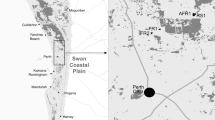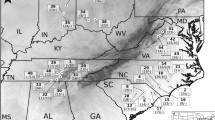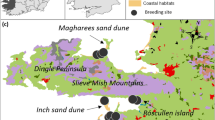Abstract
Genetic connectivity in plant populations is determined by gene movement within and among populations. When populations become genetically isolated, they are at risk of loss of genetic diversity that is critical to the long-term survival of populations. Anthropogenic landscape change and habitat fragmentation have become so pervasive that they may threaten the genetic connectivity of many plant species. The theoretical consequences of such changes are generally understood, but it is not immediately apparent how concerned we should be for real organisms, distributed across real landscapes. Our goals here are to describe how one can study gene movement of both pollen and seeds in the context of changing landscapes and to explain what we have learned so far. In the first part, we will cover methods of describing pollen movement and then review evidence for the impact of fragmentation in terms of both the level of pollen flow into populations and the genetic diversity of the resulting progeny. In the second part, we will describe methods for contemporary seed movement, and describe findings about gene flow and genetic diversity resulting from seed movement. Evidence for pollen flow suggests high connectivity, but it appears that seed dispersal into fragments may create genetic bottlenecks due to limited seed sources. Future work should address the interaction of pollen and seed flow and attention needs to be paid to both gene flow and the diversity of the incoming gene pool. Moreover, if future work is to model the impact of changing landscapes on propagule movement, with all of its ensuing consequences for genetic connectivity and demographic processes, we will need an effective integration of population genetics and landscape ecology.
Similar content being viewed by others
References
M. Abramowitz I.A. Stegun (1964) Handbook of Mathematical Functions with Formulas, Graphs and Mathematical Tables U.S. Govt. Print. Office Washington
W.T. Adams A.R. Griffin G.F. Moran (1992) ArticleTitleUsing paternity analysis to measure effective pollen dispersal in plant populations Am. Natural. 140 762–780 Occurrence Handle10.1086/285439
P.R. Aldrich J.L. Hamrick (1998) ArticleTitleReproductive dominance of pasture trees in fragmented tropical forest mosaic Science 281 103–105 Occurrence Handle9651242 Occurrence Handle1:CAS:528:DyaK1cXksVOms7Y%3D Occurrence Handle10.1126/science.281.5373.103
F. Austerlitz P.H. Garnier-Gere (2003) ArticleTitleModeling the impact of colonisation on genetic diversity and differentiation of forest trees: interaction of life cyclepollen flow and seed long-distance dispersal Heredity 90 282–290 Occurrence Handle12692580 Occurrence Handle1:STN:280:DC%2BD3s7ntlKntQ%3D%3D Occurrence Handle10.1038/sj.hdy.6800243
F. Austerlitz P.E. Smouse (2001) ArticleTitleTwo-generation analysis of pollen flow across a landscape. II. Relation between τpollen dispersal and interfemale distance Genetics 157 851–857 Occurrence Handle11157001 Occurrence Handle1:STN:280:DC%2BD3M3osFWhtg%3D%3D
F. Austerlitz P.E. Smouse (2002) ArticleTitleTwo-generation analysis of pollen flow across a landscape. IV. Estimating the dispersal parameter Genetics 161 355–363 Occurrence Handle12019249
F. Austerlitz C.W. Dick C. Dutech E.K. Klein S. Oddou-Muratorio P.E. Smouse V.L. Sork (2004) ArticleTitleUsing genetic markers to estimate the pollen dispersal curve Mol. Ecol. 13 937–954 Occurrence Handle15012767 Occurrence Handle10.1111/j.1365-294X.2004.02100.x
O. Berry M.D. Tocher S.D. Sarre (2004) ArticleTitleCan assignment tests measure dispersal? Mol. Ecol. 13 551–561 Occurrence Handle14871360 Occurrence Handle10.1046/j.1365-294X.2004.2081.x
I. Bossema (1979) ArticleTitleJays and oaks – eco-ethological study of a symbiosis Behaviour 70 1–117
B. Brookshire C. Hauser (1993) The Missouri forest ecosystem project A.R. Gillespie G.R. Parker P.E. Pope G. Rink (Eds) Proceedings of the 9th Central Hardwood Forest Conference USDA, Forest Service, North Central Forest Experiment Station St. Paul, Minnessota 289–306
J. Burczyk W.T. Adams G.F. Moran A.R. Griffin (2002) ArticleTitleComplex patterns of mating revealed in a Eucalyptus regnans seed orchard using allozyme markers and the neighbourhood model Mol. Ecol. 11 2379–2391 Occurrence Handle12406248 Occurrence Handle1:CAS:528:DC%2BD38XptlSls7g%3D Occurrence Handle10.1046/j.1365-294X.2002.01603.x
J. Burczyk I.J. Chybicki (2004) ArticleTitleCautions on direct gene flow estimation in plant populations Evolution 58 956–963 Occurrence Handle15212377 Occurrence Handle10.1554/03-200
J. Burczyk S.P. DiFazio W.T. Adams (2004) ArticleTitleGene flow in forest trees: how far do genes really travel? Forest Genet. 11 179–192 Occurrence Handle1:CAS:528:DC%2BD28XmtlKitLc%3D
J.S. Clark (1998) ArticleTitleWhy trees migrate so fast: confronting theory with dispersal biology and the paleorecord Am. Natural. 152 204–224 Occurrence Handle10.1086/286162
C.C. Cockerham B.S. Weir (1993) ArticleTitleEstimation of gene flow from F-statistics Evolution 47 855–863 Occurrence Handle10.2307/2410189
J.M. Cornuet S. Piry G. Luikart A. Estoup M. Solignac (1999) ArticleTitleNew methods employing multilocus genotypes to select or exclude populations as origins of individuals Genetics 153 1989–2000 Occurrence Handle10581301 Occurrence Handle1:STN:280:DC%2BD3c%2FltVKqsw%3D%3D
J.W. Dalling H.C. Muller-Landau S.J. Wright S.P. Hubbell (2002) ArticleTitleRole of dispersal in the recruitment limitation of Neotropical pioneer species J. Ecol. 90 714–727 Occurrence Handle10.1046/j.1365-2745.2002.00706.x
S. Darley-Hill W.C. Johnson (1981) ArticleTitleAcorn dispersal by the blue jay Cyanocitta cristata Oecologia 50 231–232 Occurrence Handle10.1007/BF00348043
M.B. Davis (1981) Quaternary history and the stability of forest communities D.C. West H.H. Shugart D.B. Botkin (Eds) Forest Succession: Concepts and Application Springer-Verlag New York 132–153
B. Devlin N.C. Ellstrand (1990) ArticleTitleThe development and application of a refined method for estimating gene flow from angiosperm paternity analysis Evolution 44 248–259 Occurrence Handle10.2307/2409404
C.W. Dick G. Etchelecu F. Austerlitz (2003) ArticleTitlePollen dispersal of Neotropical trees (Dinizia excelsa: Fabaceae) by native insects and African honeybees in pristine and fragmented Amazonian rainforest Mol. Ecol. 12 753–764 Occurrence Handle12675830 Occurrence Handle10.1046/j.1365-294X.2003.01760.x
B.D. Dow M.V. Ashley (1996) ArticleTitleMicrosatellite analysis of seed dispersal and parentage of saplings in bur oak, Quercus macrocarpa Mol. Ecol. 5 615–627
B.K. Dunphy J.L. Hamrick J. Schwagerl (2004) ArticleTitleA comparison of direct and indirect measures of gene flow in the bat-pollinated tree Hymenaea courbaril in the dry forest life zone of southwestern Puerto Rico Int. J. Plant Sci. 165 427–436 Occurrence Handle1:CAS:528:DC%2BD2cXmtFGitrg%3D Occurrence Handle10.1086/382802
Dyer R.J. 2002. Contemporary pollen movement in shortleaf pine, Pinus echinata Mill. Ph.D. Dissertion. Department of Biology, University of Missouri-St. Louis, 140 pp.
N.C. Ellstrand (1984) ArticleTitleMultiple paternity within the fruits of the wild radish Raphanus sativus Am. Natural. 123 819–828 Occurrence Handle10.1086/284241
N.C. Ellstrand D.R. Elam (1993) ArticleTitlePopulation genetics of small population size: implications for plant conservation Annu. Rev. Ecol. Syst. 23 217–242 Occurrence Handle10.1146/annurev.es.24.110193.001245
B.K. Epperson (2003) Geographical Genetics Princeton University Press Princeton
E. Essen-Moller (1938) ArticleTitleDie Beweiskraft der Ähnlichkeit im Vatershaftsnachweis Theoretische Grundlagen. Mitt. Anthropol. Ges. Wien 68 9–53
L. Excoffier P.E. Smouse J.M. Quattro (1992) ArticleTitleAnalysis of molecular variance inferred from metric distances among DNA haplotypes: application to human mitochondrial DNA restriction data Genetics 131 479–491 Occurrence Handle1644282 Occurrence Handle1:CAS:528:DyaK38XlsVCntro%3D
Fernández-M J.J. and Sork V.L. 2005. Mating patterns of a subdivided population of the Andean oak (Quercus humboldtii Bonpl. Fagaceae). J. Hered.
Fernández-M J.J. and Sork V.L. Patterns of genetic variation in fragmented forest stands of the Andean oak Quercus humboldtii Bonpl. (Fagaceae). Biotropica (in press).
R. Frankham J.D. Ballou D.A. Briscoe (2002) Introduction to Conservation Genetics Cambridge University Press Cambridge, UK
E.J. Fuchs J.A. Lobo M. Quesada (2003) ArticleTitleEffects of forest fragmentation and flowering phenology on the reproductive success and mating patterns of the tropical dry forest tree Pachira quinata Conserv. Biol. 17 149–157 Occurrence Handle10.1046/j.1523-1739.2003.01140.x
S. Gerber P. Chabrier A. Kremer (2003) ArticleTitleFAMOZ: a software for parentage analysis using dominantcodominant and uniparentally inherited markers Mol. Ecol. Notes 3 479–481 Occurrence Handle1:CAS:528:DC%2BD3sXnvVKqsb8%3D Occurrence Handle10.1046/j.1471-8286.2003.00439.x
J.A. Godoy P. Jordano (2001) ArticleTitleSeed dispersal by animals: exact identification of source trees with endocarp DNA microsatellites Mol. Ecol. 10 2275–2283 Occurrence Handle11555269 Occurrence Handle1:STN:280:DC%2BD3MrgslWiug%3D%3D Occurrence Handle10.1046/j.0962-1083.2001.01342.x
D. Grivet V.L. Sork P.E. Smouse (2005) ArticleTitleA novel approach to an old problem: tracking dispersed seeds Mol. Ecol. 14 3585–3595 Occurrence Handle16156825 Occurrence Handle10.1111/j.1365-294X.2005.02680.x
J.L. Hamrick (2004) ArticleTitleResponse of forest trees to global environmental changes Forest Ecol. Manage. 197 323–335 Occurrence Handle10.1016/j.foreco.2004.05.023
J.L. Hamrick J.D. Nason (2000) Gene flow in forest trees T.J.B. Boyle A. Young D. Boshier (Eds) Forest Conservation Genetics: Principles and Practice CIFOR and CSIRO Australia 81–90
S. Harrison A. Hastings (1996) ArticleTitleGenetic and evolutionary consequences of metapopulation structure Trends Ecol. Evol. 11 180–183 Occurrence Handle10.1016/0169-5347(96)20008-4
T.H. He S.L. Krauss B.B. Lamont B.P. Miller N.J. Enright (2004) ArticleTitleLong-distance seed dispersal in a metapopulation of Banksia hookeriana inferred from a population allocation analysis of amplified fragment length polymorphism data Mol. Ecol. 13 1099–1109 Occurrence Handle15078448 Occurrence Handle1:CAS:528:DC%2BD2cXktl2rs7s%3D Occurrence Handle10.1111/j.1365-294X.2004.02120.x
Holderegger R., Kamm U. and Gugerli F. The meaning of genetic diversity. Landscape Ecol.
A.J. Irwin J.L. Hamrick M.J.W. Godt P.E. Smouse (2003) ArticleTitleA multi-year estimate of the effective pollen donor pool for Albizia julibrissin Heredity 90 187–194 Occurrence Handle12634826 Occurrence Handle1:STN:280:DC%2BD3s7itVegtw%3D%3D Occurrence Handle10.1038/sj.hdy.6800215
T. James S. Vege P. Aldrich J.L. Hamrick (1998) ArticleTitleMating systems of three tropical dry forest tree species Biotropica 30 587–594 Occurrence Handle10.1111/j.1744-7429.1998.tb00098.x
J.M. Kabrick R.G. Jensen S.R. Shifley D.R. Larsen (2002) Wood vegetation following even-ageduneven-agedand no-harvest treatments on the Missouri Ozark Forest Ecosystem Project sites S.R. Shifley J.M. Kabrick (Eds) Proc. Second Missouri Ozark Forest Ecosystem Symposium: Post-treatment Results of the Landscape Experiment; 2000 October 17–18; St. Louis, MO U.S. Department of Agriculture Forest Service North Central Forest Experiment Station St. Paul, MN 84–101
V. LeCorre N. Machon R.J. Petit A. Kremer (1997) ArticleTitleColonization with long-distance seed dispersal and genetic structure of maternally inherited genes in forest trees: a simulation study Genet. Res. 69 117–125 Occurrence Handle10.1017/S0016672397002668
F.T. Ledig (1992) ArticleTitleHuman impacts on genetic diversity in forest ecosystems Oikos 63 87–108
S. Manel O.E. Gaggiotti R.S. Waples (2005) ArticleTitleAssignment methods: matching biological questions with appropriate techniques Trends Ecol. Evol. 20 136–142 Occurrence Handle16701357 Occurrence Handle10.1016/j.tree.2004.12.004
S. Manel M.K. Schwartz G. Luikart P. Taberlet (2003) ArticleTitleLandscape genetics: combining landscape ecology and population genetics Trends Ecol. Evol. 18 189–197 Occurrence Handle10.1016/S0169-5347(03)00008-9
T.C. Marshall J. Slate L.E.B. Kruuk J.M. Pemberton (1998) ArticleTitleStatistical confidence for likelihood-based paternity inference in natural populations Mol. Ecol. 7 639–655 Occurrence Handle9633105 Occurrence Handle1:STN:280:DyaK1c3ps1Olsw%3D%3D Occurrence Handle10.1046/j.1365-294x.1998.00374.x
J.S. McLachlan J.S. Clark S. Manos Paul (2005) ArticleTitleMolecular indicators of tree migration capacity under rapid climate change Ecology 86 2088–2098
T.R. Meagher E. Thompson (1987) ArticleTitleAnalysis of parentage for naturally established seedlings of Chamaelirium luteum Liliaceae Ecology 68 803–812 Occurrence Handle10.2307/1938351
J.D. Nason J.L. Hamrick (1997) ArticleTitleReproductive and genetic consequences of forest fragmentation: two case studies of Neotropical canopy trees J. Hered. 88 264–276
J.D. Nason E.A. Herre J.L. Hamrick (1996) ArticleTitlePaternity analysis of the breeding structure of strangler fig populations: evidence for substantial long-distance wasp dispersal J. Biogeogr. 23 501–512
D. Paetkau R. Slade M. Burden A. Estoup (2004) ArticleTitleGenetic assignment methods for the directreal-time estimation of migration rate: a simulation-based exploration of accuracy and power Mol. Ecol. 13 55–65 Occurrence Handle14653788 Occurrence Handle1:CAS:528:DC%2BD2cXhs1WksLY%3D Occurrence Handle10.1046/j.1365-294X.2004.02008.x
R. Peakall P.E. Smouse D.R. Huff (1995) ArticleTitleEvolutionary implications of allozyme and RAPD variation in diploid populations of dioecious buffalograss (Buchloë dactyloides (Nutt.) Engelm.) Mol. Ecol. 4 135–147 Occurrence Handle1:CAS:528:DyaK2MXls1CjsL0%3D
E.C. Pielou (1979) Biogeography Wiley-Interscience New York, New York, USA
J.K. Pritchard M. Stephens P. Donnelly (2000) ArticleTitleInference of population structure using multilocus genotype data Genetics 155 945–959 Occurrence Handle10835412 Occurrence Handle1:STN:280:DC%2BD3cvislKrtA%3D%3D
B. Rannala J.L. Mountain (1997) ArticleTitleDetecting immigration using multilocus genotypes Proc. Natl. Acad. Sci. USA 94 9197–9201 Occurrence Handle9256459 Occurrence Handle1:CAS:528:DyaK2sXls1Kls7w%3D Occurrence Handle10.1073/pnas.94.17.9197
K. Ritland (1989) ArticleTitleCorrelated matings in the partial selfer Mimulus guttatus Evolution 43 848–859 Occurrence Handle10.2307/2409312
K. Ritland (1990) ArticleTitleA series of FORTRAN computer programs for estimating plant mating systems J. Hered. 81 235–237
J.J. Robledo-Arnuncio R. Alía L. Gil (2004) ArticleTitleIncreased selfing and correlated paternity in a small population of a predominantly outcrossing coniferPinus sylvestris Mol. Ecol. 13 2567–2577 Occurrence Handle15315671 Occurrence Handle1:STN:280:DC%2BD2cvhtFOruw%3D%3D Occurrence Handle10.1111/j.1365-294X.2004.02251.x
O.J. Rocha G. Aguilar (2001) ArticleTitleVariation in the breeding behavior of the dry forest tree Enterolobium cyclocarpum (Guanacaste) in Costa Rica Am. J. Bot. 88 1600–1606
K. Roeder B. Devlin B.G. Lindsay (1989) ArticleTitleApplications of maximum likelihood methods to population genetic data for the estimation of individual fertilities Biometrics 45 363–379 Occurrence Handle10.2307/2531483
S.E. Russo C.K. Augspurger (2004) ArticleTitleAggregated seed dispersal by spider monkeys limits recruitment to clumped patterns in Virola calophylla Ecol. Lett. 7 1058–1067 Occurrence Handle10.1111/j.1461-0248.2004.00668.x
D.A. Saunders R.J. Hobbs C.R. Margules (1991) ArticleTitleBiological consequences of ecosystem fragmentation: a review Conserv. Biol. 5 18–32 Occurrence Handle10.1111/j.1523-1739.1991.tb00384.x
A. Schnabel (1998) Parentage analysis in plants: mating systems, gene flow, and relative fitness G.R. Carvalho (Eds) Advances in Molecular Ecology IOS Press Burke, Virginia, USA 173–189
A. Schnabel J. Nason J. Hamrick (1998) ArticleTitleUnderstanding the population genetic structure of Gleditsia triacanthos L.: seed dispersal and variation in female reproductive success Mol. Ecol. 7 819–832 Occurrence Handle10.1046/j.1365-294x.1998.00397.x
U.U. Sezen R.L. Chazdon K.E. Holsinger (2005) ArticleTitleGenetic consequences of tropical second-growth forest regeneration Science 307 891–891 Occurrence Handle15705843 Occurrence Handle1:CAS:528:DC%2BD2MXhsVGrsbg%3D Occurrence Handle10.1126/science.1105034
P.E. Smouse C. Chevillon (1998) ArticleTitleAnalytical aspects of population-specific DNA-fingerprinting for individuals J. Hered. 89 143–150 Occurrence Handle9542162 Occurrence Handle1:CAS:528:DyaK1cXivVSjsb0%3D Occurrence Handle10.1093/jhered/89.2.143
P.E. Smouse R.J. Dyer R.D. Westfall V.L. Sork (2001) ArticleTitleTwo-generation analysis of pollen flow across a landscape. I. Male gamete heterogeneity among females Evolution 55 260–271 Occurrence Handle11308084 Occurrence Handle1:CAS:528:DC%2BD3MXisFOksr0%3D Occurrence Handle10.1554/0014-3820(2001)055[0260:TGAOPF]2.0.CO;2
P.E. Smouse T.R. Meagher C.J. Kobak (1999) ArticleTitleParentage analysis in Chamaelirium luteum (L.) Gray (Liliaceae): why do some males have higher reproductive contributions? J. Evol. Biol. 12 1069–1077 Occurrence Handle10.1046/j.1420-9101.1999.00114.x
P.E. Smouse V.L. Sork (2004) ArticleTitleMeasuring pollen flow in forest trees: a comparison of alternative approaches Forest Ecol. Manage. 197 21–38 Occurrence Handle10.1016/j.foreco.2004.05.049
M.B. Soons G.W. Heil R. Nathan G.G. Katul (2004) ArticleTitleDeterminants of long-distance seed dispersal by wind in grasslands Ecology 85 3056–3068
V.L. Sork J. Nason D.R. Campbell J.F. Fernández (1999) ArticleTitleLandscape approaches to historical and contemporary gene flow in plants Trends Ecol. Evol. 14 219–224 Occurrence Handle10354623 Occurrence Handle10.1016/S0169-5347(98)01585-7
V.L. Sork F.W. Davis P.E. Smouse V.J. Apsit R.J. Dyer J.F. Fernandez B. Kuhn (2002) ArticleTitlePollen movement in declining populations of California Valley oak, Quercus lobata: where have all the fathers gone? Mol. Ecol. 11 1657–1668 Occurrence Handle12207717 Occurrence Handle1:STN:280:DC%2BD38vosleltA%3D%3D Occurrence Handle10.1046/j.1365-294X.2002.01574.x
V.L. Sork P.E. Smouse V.J. Apsit R.J. Dyer R.D. Westfall (2005) ArticleTitleA two-generation analysis of pollen pool genetic structure in flowering dogwoodCornus florida (Cornaceae), in the Missouri Ozarks Am. J. Bot. 92 262–271 Occurrence Handle1:CAS:528:DC%2BD2MXhvFOisbk%3D
R. Streiff A. Ducousso C. Lexer H. Steinkellner J. Gloessl A. Kramer (1999) ArticleTitlePollen dispersal inferred from paternity analysis in a mixed oak stand of Quercus robur L. and Q. petraea (Matt.) Liebl Mol. Ecol. 8 831–841 Occurrence Handle10.1046/j.1365-294X.1999.00637.x
G.M. White D.H. Boshier W. Powell (2002) ArticleTitleIncreased pollen flow counteracts fragmentation in a tropical dry forest: an example from Swietenia humilis Zuccarini Proc. Natl. Acad. Sci. USA 99 2038–2042 Occurrence Handle11842203 Occurrence Handle1:CAS:528:DC%2BD38XitVSrsb0%3D Occurrence Handle10.1073/pnas.042649999
S. Wright (1943) ArticleTitleIsolation by distance Genetics 28 114–138
S. Wright (1946) ArticleTitleIsolation by distance under diverse systems of mating Genetics 31 39–59
S.J. Wright H.C. Duber (2001) ArticleTitlePoachers and forest fragmentation alter seed dispersal, seed survival, and seedling recruitment in the palm Attalea butyraceaewith implications for tropical tree diversity Biotropica 33 583–595
A.G. Young T. Boyle T. Brown (1996) ArticleTitleThe population genetic consequences of habitat fragmentation for plants Trends Ecol. Evol. 11 413–418 Occurrence Handle10.1016/0169-5347(96)10045-8
A.G. Young G.M. Clarke (Eds) (2000) Genetics, Demography, and Viability of Fragmented Populations Cambridge University Press Cambridge, UK
Author information
Authors and Affiliations
Corresponding author
Rights and permissions
About this article
Cite this article
Sork, V.L., Smouse, P.E. Genetic analysis of landscape connectivity in tree populations. Landscape Ecol 21, 821–836 (2006). https://doi.org/10.1007/s10980-005-5415-9
Received:
Accepted:
Issue Date:
DOI: https://doi.org/10.1007/s10980-005-5415-9




